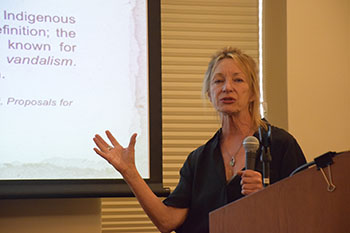Peg LeVine Explains Ritualcide in Cambodia in Center Fellow Lecture

 During her lecture as the 2014-15 Center Fellow of the USC Shoah Foundation Center for Advanced Genocide Research on Thursday at USC Doheny Memorial Library, Peg LeVine shared her experiences studying a unique form of violence during the Cambodian Genocide. She has coined it “ritualcide,” and for the people of Cambodia, it is a distinct form of terror that still affects survivors to this day.
During her lecture as the 2014-15 Center Fellow of the USC Shoah Foundation Center for Advanced Genocide Research on Thursday at USC Doheny Memorial Library, Peg LeVine shared her experiences studying a unique form of violence during the Cambodian Genocide. She has coined it “ritualcide,” and for the people of Cambodia, it is a distinct form of terror that still affects survivors to this day.
LeVine, who is a trauma psychologist, anthropologist, Asian studies scholar, and sculptor based in Australia, spent many years traveling and working with survivors of the Cambodian Genocide, which killed 1.5 – 3 million people under Pol Pot’s Khmer Rouge regime from 1975-1979. LeVine said she became interested in the ritual and spirit infrastructure before, during and after the Khmer Rouge’s takeover of Cambodia (during which time the country was renamed Democratic Kampuchea), and began capturing genocide survivors’ spirit experiences on film.
Cambodians have long held deeply ritualized cosmological beliefs about birth, death, marriage, illness and more. But under the Khmer Rouge, these rituals were disrupted. People were not buried according to tradition and were often killed violently, so people became fearful that the spirits of the dead would roam and cause harm. They were cut off from support systems during pregnancy and birth.
The Khmer Rouge also arranged marriages between people who were deemed a good match. People who did not have a good match were killed. As a result, LeVine said many couples who were married under the Khmer Rouge feel shame, viewing their marriage as sinful and feeling guilt for their friends and family who were killed.
LeVine noted the distinction between two types of marriages according to Cambodian belief: Ku Prean and Ku Kam. Ku Prean marriages are believed to have been arranged by Buddha before either spouse was born, and will last forever. Ku Kam, on the other hand, means “sin”: these marriages will break up at some point. Many couples married under the Khmer Rouge feel their marriages are Ku Kam.
LeVine also discussed “Angkar,” a powerful spirit that many Cambodians believe is the cause of chaos, destruction and violence. LeVine said myths such as Angkar gave the Khmer Rouge more power, since such myths consume people’s imaginations and cause fear and other psychological trauma. She showed one video of an interview with a Cambodian survivor who suddenly enters into a dissociative state, staring into the distance, in the middle of a conversation about disruption of rituals during the genocide. Later, he explained that at that moment Angkar had “taken his body.” Such psychological trauma still affects survivors, even those who have since left Cambodia and settled in the United States and around the world, LeVine said.
This disruption and destruction of sacred rituals under the Khmer Rouge is what LeVine calls “ritualcide.” Ritualcide is not necessarily connected to genocide, but the erosion of ritual access can advance genocidal priming, she said. Ritualcide erodes family, community, ancestral networks and a sense of cosmological predictability, and renders people susceptible to terror and trauma fallout for the living and the dead.
At the end of the lecture, LeVine showed clips from the Visual History Archive of Holocaust survivors whose religious rituals were also affected by the Nazi regime. She also showed sculptures she made that represent Angkar its effect on people.
Like this article? Get our e-newsletter.
Be the first to learn about new articles and personal stories like the one you've just read.